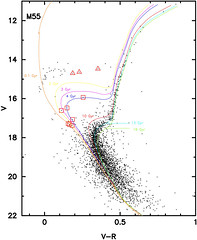
M55 CMD
Originally uploaded by Astro Guy.
This is a colour brightness plot (more commonly known as a colour-magnitude diagram or CMD) of stars in the globular cluster M55.
The black dots show the measurements for each star. There is probably about 4000 data points. Overlayed are various models that describe the age of the cluster.
A globular cluster is a great object to understand the evolution of stars. All stars in the globular cluster were born at the same time - around 13 giga-years (Gyr) ago (that's 13 000 000 000 years ago!). The more massive the star, the faster it burns hydrogen. As the hydrogen fuel source runs out, the structure of the star changes. This can be observed as change in colour and brightness. So the 0.1 Gyr line on the plot shows what the diagram would look like 100 million years have the birth of all the stars. The 13 Gyr line does a good job describing what the cluster looks like to us now. For dim stars (V less than 20) you can see that all the model tracks match. These stars,
because of their low mass, evolve very slowly, where as all the bright
massive stars are gone. By locating what is known as the cluster turn off (the bend in the data points at V=18, V-R=0.4) we can estimate the age of the cluster.
Now all this is well known, but what interests me are the data points that have squares and triangles around them. The triangles are RR Lyra stars, like AQ Leo I talked briefly about in a previous post. The squares are pulsating blue stragglers. They are metal poor delta scuti stars in the cluster. The problem, is that these don't match the age of the cluster. The isochrones (the model lines) show ages less than 4 Gyr. These stars are massive enough that if they were the age of the cluster they would of ceased core hydrogen burning a long time ago. They seem to be evolving too slow, hense the same Blue Stragglers.
(Side note: Originally abbrivated as BS --whoops-- are now seen as BSs in literature)
There are two theories to explain the existance of BSs:
1. Captured from the Halo/Disc of the Milky Way as the globular cluster oribits the galaxy.
2. Two stars collided and merged. (most like a binary system through three body interaction)
Each may be pauslible. My idea is to match the pulsation frequencies of the variable stars to different models with different characteristics - such as composition and rotation and see if the results are consistent with either of the two theories. There is also the possibility that both are correct. Should be exciting.
No comments:
Post a Comment